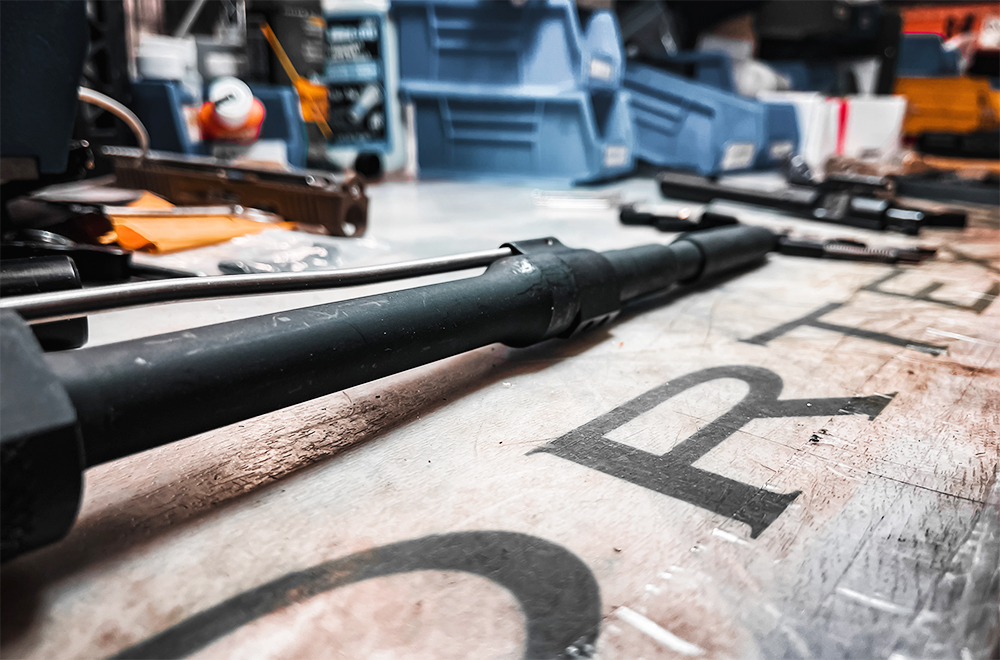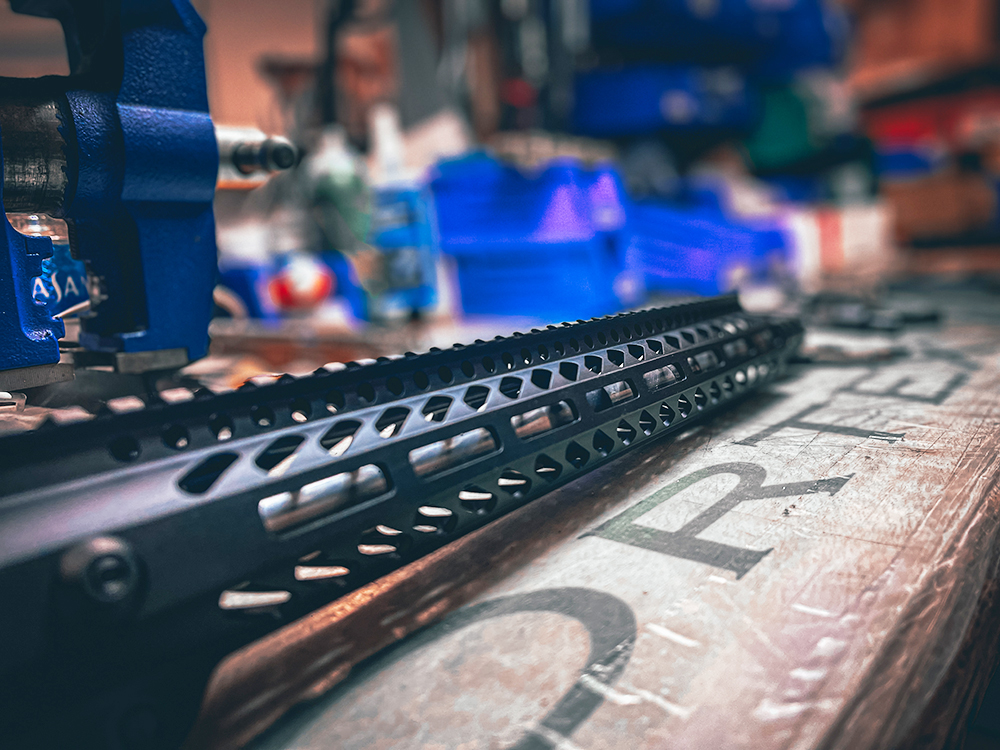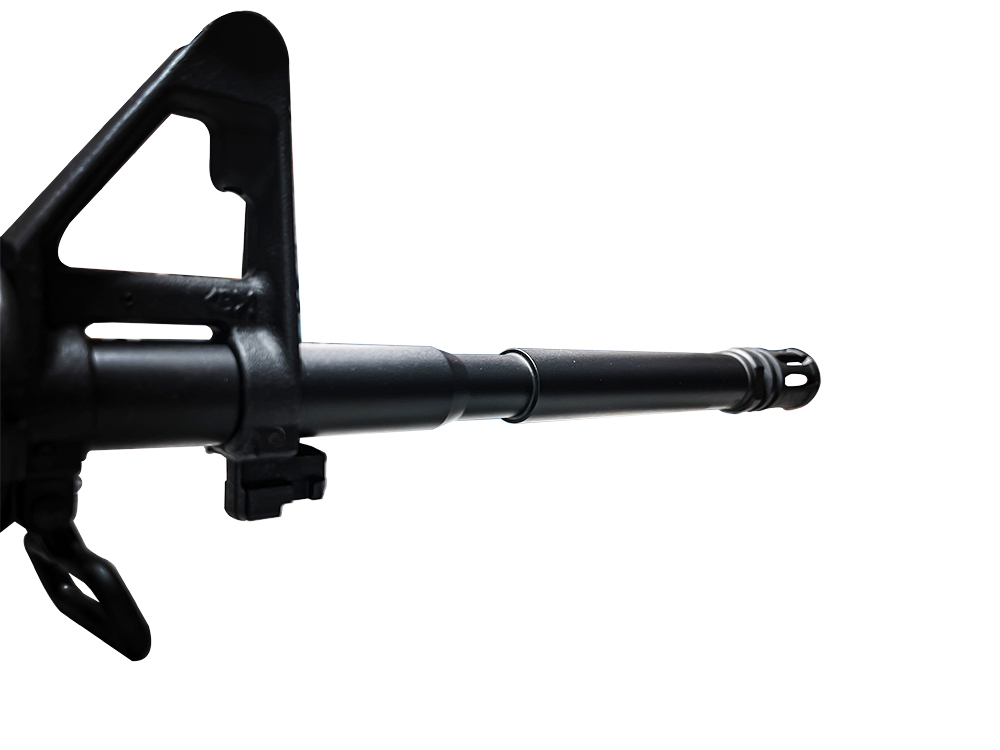AR15 Barrel Types and Materials
When planning for your new AR build, one might just pick any old barrel as long as it’s for the right caliber and the length you want it at. But there are different types of barrels and these differences do matter. In this article we go over the various AR-15 barrel types and materials to help better inform your AR 15 build process.
AR-15 Barrels
There are 3 main types of barrels when it comes to how rifling within the barrel is made that you need to be aware of — these methods include barrels with cut rifling, button rifling or ones that were cold hammer forged. Today’s article focuses on the barrel materials so if you want to do a deep dive on this topic check out our previous blog that compared cut rifling vs button rifling and cold hammer forged barrels.
Cold Hammer Forged (CHF)
Cold hammer forged barrels are known in short as ‘CHF.’ The process of making CHF barrels involves a barrel blank with a mandrel inside of it. On this mandrel is the shape, or reverse image, of the rifling and twist rate. The barrel blank and mandrel is placed in a forge four hammers on all sides hammer down to create the rifling in the barrel. Here are the main pros and cons of CHF barrels:
Pros
- Forging process allows for higher heat resistance.
- Large round count = longer service life than other barrel types.
- Seen as a premium part, typically more accurate than other barrel types.
Cons
- Potentially not as accurate as other barrel types depending on brand.
Cut-Rifled
The first rifling method to date, which is now done with modern machinery. To make a cut-rifled barrel, a hook is pulled through a rotating barrel blank that cuts away material to create the rifling in a specific twist rate. This hook has to be pulled through the barrel’s bore on multiple passes before the process is complete.
Pros
- Consistent rifling twist rate.
- Tight tolerances.
- Process imposes little to no stress on barrel.
- Great for precision shooting, high accuracy (Sub MOA performance).
Cons
- Expensive, slow process.
- Non-scalable for mass production.
Button-Rifled
Button rifling is an extremely fast process which allows manufacturers to quickly make many barrels. With button rifling, an extremely hard button made out of tungsten carbide that has the reverse shape of the rifling is used to create the rifling in barrel bores. The button can be either pushed or pulled through the barrel blank depending on the manufacturer’s preference.
Pros
- Process only requires a single pass through with the button.
- Affordable pricing, wide availability.
- Can create very accurate barrels.
Cons
- Must be stress-relieved after rifling.
- Some barrels can be cheap, low quality.
Which AR15 barrel type is best?
At the end of the day, every avid shooter is going to swear by what they use and that’s going to vary per person. One guy might only use CHF barrels, another might swear by a cut rifled or a button rifled barrel. Disregarding the less common barrel types that we didn’t mention in this blog aside (i.e. track rifling used by TRIARC) there’s give and take with every type of rifling.
The average AR15 barrel is most likely going to be button rifled just because they are the cheapest to make and the most readily available. Even the barrels from guns that people make fun of for being more “budget” will last around ten thousand rounds and that’s more than the most gun owners will ever even shoot in a lifetime. With cut rifled barrels, some precision shooters will proclaim that these are the absolute best because they last longer than button rifled barrels.
Well, that’s not super difficult to achieve as high quality cold hammer forged barrels are known to last a minimum of 20,000 rounds and some have been documented to have lasted up to 30k rounds. However, that’s not to say there aren’t extremely accurate button rifled barrels as well, they just might not last as long as cut rifled or cold hammer forged barrels. It would be more accurate to say that there is a wide variety of barrel qualities with each type of barrel rifling method depending on the maker.
AR-15 Barrel Materials
Now that we’ve covered the meat and potatoes of AR15 barrel rifling, we move on to the types of materials used to make the barrels in question. There are several, and they all fall into one of either categories as a carbon barrel or stainless steel barrel.
Carbon Barrels
These carbon steels are also known as low alloy steel. To clarify, the following materials are all a type of steel that is made up of a combination of elements but the common denominator here would be carbon and iron. Along with other elements, they are placed into an electric or oxygen furnace to be turned into a molten state before being combined to form one solid piece of metal.
- 4140 Carbon Steel - One of the more common barrel materials which is made up of about 0.4% carbon content. That’s the ‘40’ in 4140 carbon steel. The ‘41’ refers to it being a type of chromium-molybdenum steel.
- 4150 Carbon Steel - Another one of the more common barrel materials which is made up of 0.5% carbon content. That’s the ‘50’ in 4150 carbon steel.
- Chrome-Moly Vanadium (CMV) - So now you know that both 4140 and 4150 Carbon Steel both have Chrome-Moly in them. With the addition of vanadium, a transition metal, it makes the metal stronger and as a bonus it naturally gives off a layer of oxide on the surface material.
- 4150 CMV - Put them together, what have you got? Bippity, boppity boo. Just kidding, but yeah 4150 CMV is simply 4150 Carbon Steel that’s had vanadium added to it and when used to make a barrel it becomes highly durable and reliable.
Stainless Steel Barrels
SS barrels - also known as stainless steel barrels. These are the shiny barrels you see sticking out of AR15 handguards and rails. I used to think that it was stylistically a poor choice for older people but there are environmental and functional reasons to buy and use stainless steel for AR rifle barrels.
The main advantage to using stainless steel barrels is that they have higher corrosion resistance compared to standard carbon steel barrels that are uncoated (but basically all carbon steel barrels are coated in a type of finish so this point is moot). These can be helpful for those in more humid environments or for those that expect their barrels to regularly get wet. That being said, while the 400 series of stainless steels are more corrosion resistant, they will still rust if not properly cared for.
- 410 Stainless Steel - Within the 400 series of stainless steels (also known as martensitic) it is the least strong as it is a general purpose grade that’s still very hard but soft enough to be machined if necessary. To create a quality barrel out of 410SS it requires heat treatment but many shooters’ concern is that if exposed to sub zero temperatures there would be a high chance for barrel failure.
- 416 Stainless Steel - 416 grade stainless steel is the most machinable steel of the bunch due to its low cost and sulphur being added to the mix which creates manganese sulphide. This actually results in lowering corrosion resistance so while a 416 SS barrel may be fine if exposed to fresh water, it would not hold up as well against salt water.
- 416R Stainless Steel - Not to be confused with 416 SS, 416R SS is a stronger metal that doesn’t fail under sub zero temperatures (should hold up to about -40 degrees Fahrenheit) which makes it a great choice for AR15 barrels and shooters that expect to be shooting often and require greater consistency for accuracy. However, they can be expected to be more expensive.
- 17-4 PH Stainless - Not commonly talked about or sold anymore but in the early 2000’s this material was used to make higher quality and more hardened versions of stainless steel for an AR15 rifle barrel. 17-4PH is also known as 630 Stainless Steel which is frequently used by engineers and designers for mechanical purposes and a wide variety of products as it can withstand temperatures of up to 600 degrees Fahrenheit.
What is the best AR barrel material?
In our opinion, with the modern technology we have today and the updates that have been made in barrel manufacturing in the past couple of decades we think that 4150 CMV is the best AR15 barrel material and for all AR rifle barrels for that matter. The important factor to not forget is what the barrel is coated or finished with which is what we’ll get into next.
AR-15 Barrel Finishes
Last but not least on the topic of AR 15 barrel types and materials is the finish. What kind of coating should you select for your AR rifle? Which one is best? Should we avoid any of them? Let’s discuss.
Parkerized
Parkerizing is really synonymous to phosphating as it’s a technique to coat metal or firearms parts in particular. During the World War 2 era, this method was more known as “blueing” but the finishing standards have since been made more tough per military standards and needs. The end result is what we have today which is manganese phosphate, a treatment that falls under the term of “parkerized” barrels.
The verb “parkerizing” comes from an old company that used to offer phosphating services from 1915 to the 1950s called the Parker Rust-Proof Phosphating Company. A general idea for many firearms and firearms parts is that if it’s good enough for the military and for combat, it’s good enough for civilians too. Manganese phosphate is a good finish for AR15 barrels as it creates a tough matte finish that’s anti-reflective, durable and its properties excel at holding oil.
Chrome Lined
Chrome lined barrels can handle adverse weather and higher round counts but what you need to know about this term is that it refers to the inner bore lining of the barrel, not the coating on the exterior. AR rifle barrels will usually either be chrome lined in the bore; for barrels without chrome lining in the bore they are known as “match grade” barrels and are typically made out of stainless steel.
Nitride Coated
In 2021, nitride coated AR15 barrels are the most common finish you’ll see regardless of quality, type or brand. Why is this? It’s because the process of nitriding an AR rifle barrel greatly increases corrosion resistance (even more than chrome lined barrels) while maintaining the shape of the bore. Nitride coating is applied not only to the barrel’s exterior but the bore as well. The keywords here are dimensional consistency which equate to improved accuracy.
That doesn’t mean that nitride coating is perfect though. It’s only caveat is that it is not as heat resistant as chrome lined barrels. If abused with excessive heat, it is likely to cause failures sooner than it naturally would through the course of normal wear and tear.
Black nitride also happens to look very nice. Because it’s such a hard finish, it acts as a very protective coating making drops, scratches or scuffs of no real concern. The last benefit to nitriding is that the process itself is the easiest and cheapest to do which reduces cost for both the manufacturer and consumer. Gun owners will even take their stainless steel barrels to be nitride coated just for that extra layer of protection.
Twist Rate & Length
What is barrel twist rate? You’re familiar with the iconic 007 James Bond theme where we see him through a barrel with twisting lines right? Well, the rate of the spin that this lining creates is known as the twist rate. The most common AR15 barrel twist rates are 1:7, 1:8 and 1:9. This means that once fired, a bullet will spin over one full time every 7, 8 or 9 inches of barrel it travels through depending on the twist rate. Make sense?
This is also why longer barrels can produce more projectile velocity as they are spun up before exiting the barrel for their flight path. When looking into barrel twist rate and lengths you want to pick one that makes sense for you based on the ammunition you plan on using as well. If combined incorrectly you won’t get nice hole punches on your targets but what’s called “keyholing” instead. That’s bad. We don’t want that to happen because the projectile isn’t spinning like a football while on its flight path but is tumbling through the air instead which greatly reduces its effectiveness on impact.
1:7 Twist
Without getting too deep into the ballistics, this twist rate is generally chosen for shorter barrels and works well with heavier projectiles. It’s what’s currently used in our military, if that makes any difference to you.
1:8 Twist
This twist rate is what’s most commonly seen purchased on the civilian market as it works a variety of barrel lengths from 14 to 18 inches. If you’re shooting 5.56 NATO then know that standard M193 or M855 with 62 grain bullets will work best here. Still, it’s the best middle ground twist rate of the three.
1:9 Twist
Among the most common twist rates for AR15 barrels, 1:9 is the slowest and performs best with lighter bullets. Basically anything less than 62 grains will perform well with this twist rate.
Start Your AR-15 Build with 80% Arms!
Now that you’re an expert in AR-15 barrel types and materials, you’re ready to build your next AR-15! Lucky for you, this information (other than the twist rate) remains true for AR9s and AR10s too! We have everything you need to put together an AR-15 rifle build starting with an 80% lower receiver. If you’ve never completed an 80 lower before you’ll need our Easy Jig® Gen 3 to be able to mill out any mil-spec 80 percent AR15 lower receiver on the market. If you need any help, we’re only ever an email away.



 Back to List
Back to List